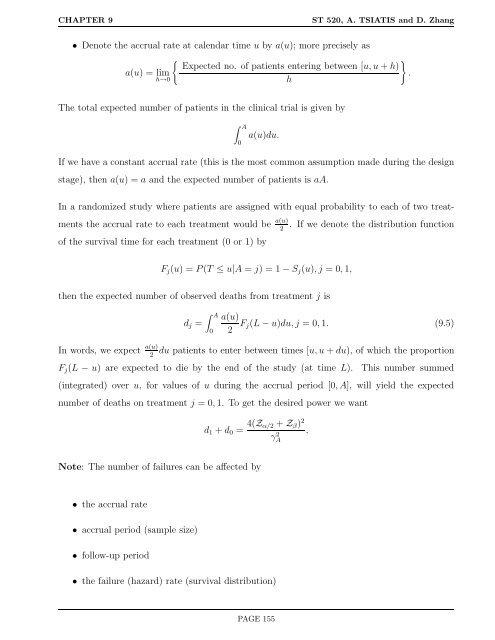ST 520 Statistical Principles of Clinical Trials - NCSU Statistics ...
ST 520 Statistical Principles of Clinical Trials - NCSU Statistics ...
ST 520 Statistical Principles of Clinical Trials - NCSU Statistics ...
Create successful ePaper yourself
Turn your PDF publications into a flip-book with our unique Google optimized e-Paper software.
CHAPTER 9 <strong>ST</strong> <strong>520</strong>, A. TSIATIS and D. Zhang<br />
• Denote the accrual rate at calendar time u by a(u); more precisely as<br />
� �<br />
Expected no. <strong>of</strong> patients entering between [u, u + h)<br />
a(u) = lim<br />
.<br />
h→0<br />
h<br />
The total expected number <strong>of</strong> patients in the clinical trial is given by<br />
� A<br />
a(u)du.<br />
0<br />
If we have a constant accrual rate (this is the most common assumption made during the design<br />
stage), then a(u) = a and the expected number <strong>of</strong> patients is aA.<br />
In a randomized study where patients are assigned with equal probability to each <strong>of</strong> two treat-<br />
ments the accrual rate to each treatment would be a(u)<br />
. If we denote the distribution function<br />
2<br />
<strong>of</strong> the survival time for each treatment (0 or 1) by<br />
Fj(u) = P(T ≤ u|A = j) = 1 − Sj(u), j = 0, 1,<br />
then the expected number <strong>of</strong> observed deaths from treatment j is<br />
� A<br />
dj =<br />
0<br />
a(u)<br />
2 Fj(L − u)du, j = 0, 1. (9.5)<br />
In words, we expect a(u)<br />
du patients to enter between times [u, u + du), <strong>of</strong> which the proportion<br />
2<br />
Fj(L − u) are expected to die by the end <strong>of</strong> the study (at time L). This number summed<br />
(integrated) over u, for values <strong>of</strong> u during the accrual period [0, A], will yield the expected<br />
number <strong>of</strong> deaths on treatment j = 0, 1. To get the desired power we want<br />
d1 + d0 = 4(Zα/2 + Zβ) 2<br />
γ2 ,<br />
A<br />
Note: The number <strong>of</strong> failures can be affected by<br />
• the accrual rate<br />
• accrual period (sample size)<br />
• follow-up period<br />
• the failure (hazard) rate (survival distribution)<br />
PAGE 155
















